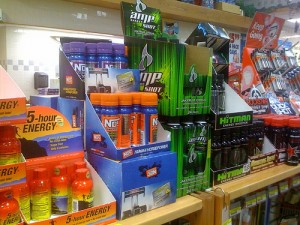
Photo used under Creative Commons from Joe Marinaro
Energy drinks are the latest thing. You have seen them-those cute little bottles sitting neatly to the right or left of the cash register in gas stations, pharmacies, grocery stores and convenience stores. They have been spotted on the counters at Bed Bath and Beyond and local pet stores. They are everywhere, hoping to provide you with that much needed burst of energy when you are feeling exhausted.
Their labels are cute and trendy, appealing mainly to teens and students who need to pull all-nighters, but reaching people of all ages. Their marketing claims to provide you with the energy you need to increase mental alertness and physical performance. The 5-hour ENERGY company claims “The two-ounce energy shot takes just seconds to drink and in minutes you’re feeling bright and alert. And that feeling lasts for hours.”
Let’s face it, we all feel exhausted at times-work, school, family, staying up too late. A little “pick me up” can be attractive. Many people continue to use coffee for caffeine intake-a known stimulant. The energy drinks bank on the attractiveness of a quick fix-just down the shot and you will feel the long lasting effects immediately. That’s why they are so appealing-they provide a quick punch; high dose of caffeine and instant effect. They are also available in many sizes and anyone can buy them, regardless of age.
There is no question that the drinks do work. They will keep you up for the promised 5 hours and sometimes much longer. The bigger problem is that we are not listening to our bodies when they need rest- drinking an energy drink is no substitution for the sleep your body requires.
What’s in those little shots of “energy”?
- Caffeine-caffeine can be found in coffee, soda and non-herbal teas. It is found in much higher quantities in energy drinks. Most energy drinks contain between 70 and 300 mg. An 8 oz cup of coffee contains 110-150mg for drip, 65-125mg for percolated, and 40-80 mg for instant. An 8 oz can of soda contains between 30-40 mg caffeine. An 8.4 oz can of Spike Shooter contains 300 mg of caffeine. Caffeine’s drug half life is perhaps 5-10 hours for many, though it can extend to 16 or more hours for some. That means, on the good side, half the caffeine dose is gone in 5 hours, three-quarters in 10 hours, seven-eighths in 15 hours. For many, sizable blood levels of caffeine never go away — which means they never properly sleep. Yikes!!
- Taurine-taurine is an amino acid that our body naturally produces. Studies have shown that synthetic taurine is linked to illnesses ranging from high blood pressure to strokes and seizures to heart disease. It has been banned in some Scandinavian countries – like Switzerland – after being linked to the deaths of three consumers.
- Guarana-guarana comes from plants in South America and is extremely prevalent in Brazil. Amazonian s have used it for a long time to increase alertness and energy. It’s denser in caffeine than coffee beans (about 2–4.5% caffeine in guarana seeds compared to 1–2% for coffee beans). Guarana is one of the richest sources of caffeine, containing up to three times the amount of caffeine as coffee. Unlike coffee, the amount of caffeine doesn’t have to be listed on guarana drinks. Initial symptoms of guarana overdose include difficulty urinating, vomiting, and abdominal cramps and spasms.
- Sugar-most energy drinks contain a huge amount of sugar, although there are a few sugar free options on the market. Some energy drinks have the equivalent of 4 teaspoons of sugar. Each teaspoon of sugar contains about 15 calories. Many of the drinks come over-sized containing 3 or 4 servings per container. If this is consumed on a regular basis it could very easily contribute to the ongoing obesity problems we are seeing among children.
The danger of the drink
There are many ingredients in energy drinks. There isn’t enough information to know the long term effects on our bodies. We also don’t know enough about the interaction when they are all mixed together, used in high doses or mixed with other substances such as alcohol.
Caffeine is addictive-the more you drink the more you want. Coffee is generally sipped and drank slowly. Energy drinks are chugged and enter our systems quickly, giving us a burst of all these ingredients at once. Caffeine causes dehydration. We become thirsty and keep drinking-causing a vicious cycle. Caffeine keeps us awake-so we don’t get the requisite hours of sleep our bodies need. A lot of people experience side effects when they have over 200mg of caffeine in their system, including sleeplessness, anxiety, heart palpitations, irritability, headaches, nausea, muscle tremors, anxiety and the jitters.
Alternatives to Energy Drinks
- Drink water!
- Get plenty of sleep
- Eating healthy and exercise are really the best ways to help the body tap into its own energy source.
Have you tried an energy drink? How did it effect you? Tell us all about it!
Sources:
Coffee vs. Energy Drinks: The Caffeine Wars

